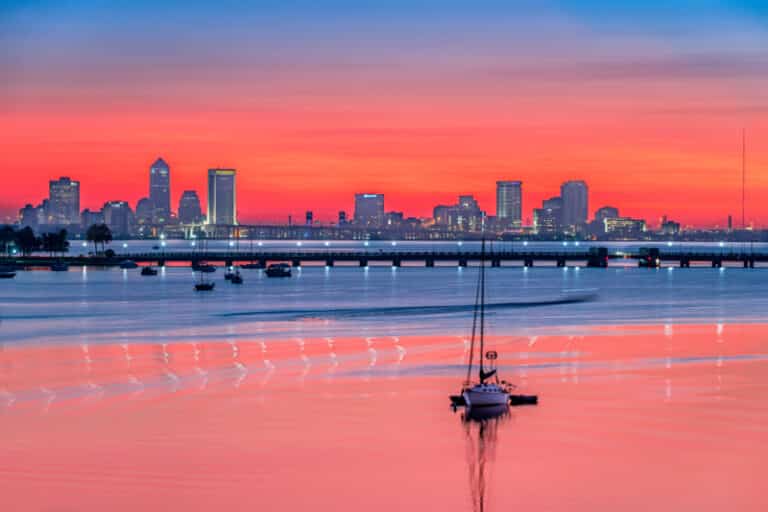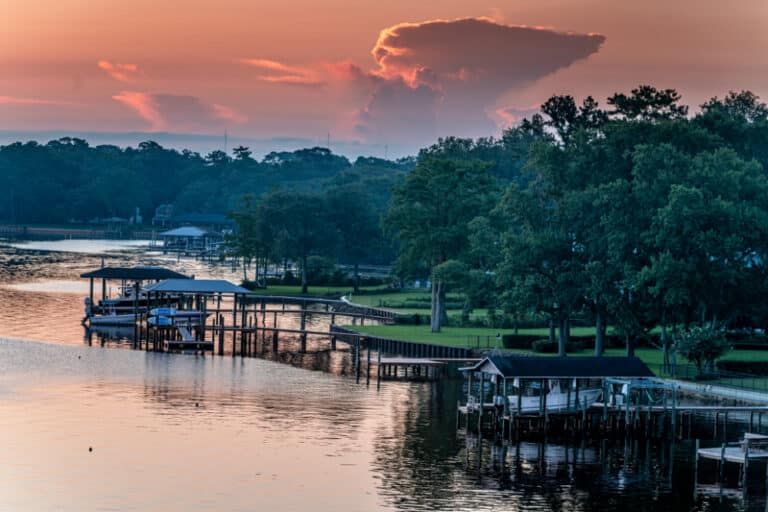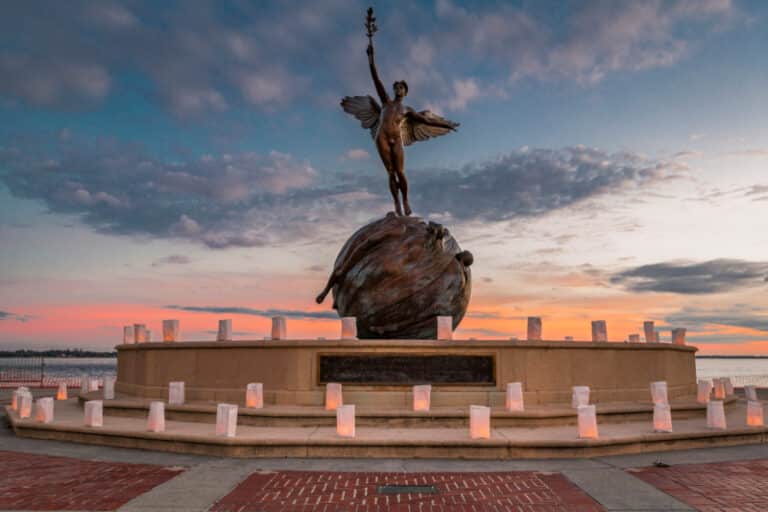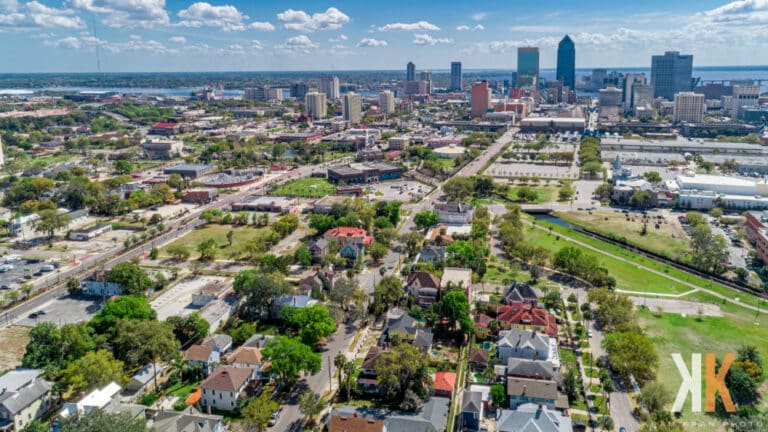
Living Luxe / Summer 2020
By Allie Leweke
Historic Neighborhoods of the Bold New City
Strolling through Jacksonville’s snapshots of the past.

Rich in square mileage and rich in history, Jacksonville — conveniently located just 40 miles north of the nation’s oldest European settlement — has a lot to offer when it comes to exploring how past generations have inhabited our fair city. The First Coast’s dense cluster of historic neighborhoods, with an array of classic architectural styles and a commitment to preserving pieces of its history, provides snapshots of what it might have been like to take up residence here, from well before its official founding in 1822 on through the 19th century and up to the present day.
Long before the Bold New City’s residents flocked to the beach for a taste of the “salt life,” homes were primarily concentrated in the geographic vicinity surrounding the riverways in what became Downtown Jacksonville. In fact, what was dubbed “South Jacksonville,” the southeastern part of Duval County now known as Southside, was only annexed in 1932, long after these historic neighborhoods had already blossomed along the St. Johns River.
The Downtown of today is still where many of the city’s oldest structures, landmarks and offices remain. Its historic roster includes two buildings that now house luxury and loft-style apartments — The Carling, originally constructed as a hotel in 1925, and 11 East Forsyth, built one year later, and having served as the American Heritage Life Insurance Company headquarters — each of which can be found on the official U.S. National Register of Historic Places. The Florida Theatre opened as an entertainment venue in 1927 with a stage that has showcased a variety of acts, perhaps most famously, Elvis Presley in 1956. And no Jacksonville skyline image is complete without a bridge or two, leading out to what grew to become the largest city by area in the entire country — including some notable historic neighborhoods.
From Old Ortega’s 18th-century origins and the establishment of Springfield in 1869 to the flurry of residential activity that resulted in the revered Riverside, Avondale and San Marco neighborhoods, these beloved homes and businesses have collectively created a city we know and love and put Jacksonville on the proverbial (and literal) map.

ORTEGA
An ‘Oldie’ (and Very Goodie)
Old Ortega, as developed in the early 1900s by John N. C. Stockton and Charles C. Bettes of the Ortega Company, is the stuff idyllic family portraits are made of. An inland island, it was officially connected to Jacksonville proper by the Ortega Bridge (restored in 1927) and remains bordered by water — with the St. Johns River to the east and the Ortega River to the west.
But Old Ortega’s origin starts more than a century prior, where it was home to some of history’s more colorful characters, including one for which the Ortega River’s pseudonym, McGirts Creek, was named. In the late 1700s, Daniel McGirt, a Revolutionary War “flip-flopper,” planter and all-around outlaw, made the island now beloved as Old Ortega his home — using it to evade any number of countries with a bounty on his head.
Perhaps Old Ortega’s favorite piece of lore is the idea that the notorious George “Machine Gun” Kelly and his wife absconded from their stately Mediterranean Revival home in the middle of the night in 1933, before a federal raid the following morning. But these fun historical anecdotes aren’t the only thing drawing Jacksonville residents to the Pleasantville-esque neighborhood.
With plenty of waterfront property and river access, families can realize their dream of waking up each day to the promise of the Florida sun rising across a glimmering body of water. Many of these homes were once the brainchild of famed architect Henry John Klutho, who led Jacksonville in its rebirth following the Great Fire of 1901, a disaster that tragically decimated much of the city’s earlier development. Known for his Prairie School style of architecture, Klutho’s structures pay homage to his Midwestern upbringing and add a touch of the wholesome and the horizontal to Jacksonville’s Southern roots.
However, with more than a century of growth and evolution, you’ll now find almost every architectural aesthetic under the sun in Ortega. From Mediterranean-inspired villas to Tudor Revivals harkening an English countryside, each one contributes to the area’s frequent appearance on “most beautiful neighborhoods” lists.
See and Be Seen
Along with its collection of history, this notable neighborhood carries some serious social cache. Though it doesn’t boast the same repertoire of fine dining establishments as the Riverside/Avondale and San Marco areas, Old Ortega’s water access and appreciation for Southern tradition provides the perfect backdrop for its yacht and river clubs.
The Florida Yacht Club originated in 1876 and is a popular members-only venue for some of Jacksonville’s oldest families. In 1903, the Germania Club appeared on the scene in what is now Brooklyn and moved to Ortega proper in 1928 under the new moniker “The German American Club” — a decade ago it underwent a major renovation and was finally dubbed the Ortega River Club. Founded in 1921, the Timuquana Country Club is another popular club and golf course.
If you prefer a more laid-back way to enjoy Old Ortega, it also houses one of the state’s finest collection of parks: Baltic Street at the northern end of the island connects three such noteworthy grounds, namely Bettes Park, Cortez Park and Columbus Park. Or find a secluded bench underneath Spanish moss-draped oaks in lovely Seminole Park to take in peaceful views of the Ortega River.

RIVERSIDE & AVONDALE
Here’s to 100 Years (and 50 More)
Perhaps the two most popular historic neighborhoods in Jacksonville are neighbors themselves; in fact, you may not notice where one ends and the other begins. Riverside, officially platted in 1869, and Avondale, established in 1920, represent two of Jacksonville’s most vibrant and culturally diverse communities, each celebrating major birthdays right now — 150 and 100 years, respectively.
Riverside, appropriately named for its proximity to the St. Johns River, was originally sold for $10,000 in gold to Florida Union editor Edward M. Cheney and Boston developer John Murray Forbes. Much like San Marco and Springfield, though established in the late 19th century, Riverside truly blossomed in the early 1900s post-fire. Its range in architecture is representative of the evolving socioeconomic development throughout the past 150 years, as evidenced in the three-story Colonial Revival mansion once known as the Martha Washington Hotel (now condominiums), not to mention a large number of bungalow plantation houses.
Avondale was added to the mix on the verge of the Great Depression and was intended to be Jacksonville’s wealthiest development. With stately homes protected by majestic oak trees along the St. Johns River, Avondale remains a peaceful respite 100 years after its inception, with a large number of expansive Mediterranean Revival estates accented by Tudors, Shakers and some Klutho-inspired abodes.
Both neighborhoods boast large, old houses and, more importantly, residents who are committed to maintaining the integrity of the homes’ architecture and experience. In fact, each neighborhood is recognized by the National Register of Historic Places, with Riverside — and its 6,870 acres and an astonishing 2,120 historic buildings — being the first district in Jacksonville to achieve such distinction. The successful safeguarding of treasured days past is due in large part to the hard work done by Riverside Avondale Preservation (RAP) and the Jacksonville Historic Preservation Commission — two groups devoted to keeping these gems intact and alive, following a mid-20th century influx of development.
Decades of the preservation groups’ work has been compiled into a book titled Jacksonville’s Architectural Heritage: Landmarks for the Future, written by RAP’s founder, Dr. Wayne Wood, in which you’ll see the 15 sites that have been earmarked for safeguarding.
Live and Let Live
Residents and visitors to these sister neighborhoods continue to enjoy a thriving lifestyle that is easily accessed by foot or bicycle. With some of the city’s finest restaurants, coffee shops, boutiques and historic landmarks all a stone’s throw apart, Riverside and Avondale offer a great “staycation” vibe to those living in more modern parts of Jacksonville.
Riverside Avondale Preservation is dedicated not only to protecting the architectural heritage and history of the area, but encouraging a lively community rich in culture. One way it does this is by hosting the Riverside Arts Market underneath the Fuller-Warren Bridge every Saturday where visitors can enjoy sights, sounds, tastes and wares from the city’s most eclectic makers and doers.
And if we’re being honest, you’re not a true Jacksonville resident until you’ve taken a stroll through the nearby Cummer Museum of Art & Gardens. The Cummer was born following the death of its primary benefactor, Ninah Cummer, who amassed an impressive personal art collection and constructed her own Italian garden — all of which are still part of the museum today. And its gardens, after suffering severe damage during 2017’s Hurricane Irma, are finally returning to their luscious glory and serve as an incredible backdrop for fabulous events throughout the year.
A short jaunt from the arts market and Cummer Museum lies the historic 5 Points shopping district — named for a unique five-lane intersection converging on the unofficial center of Riverside, with a distinct bohemian vibe emanating from each of its pathways. Millennials and Gen Z walk among the neighborhood’s longest tenured inhabitants to enjoy an ambience that is, at once, chic and gritty, trendy and unpretentious. Spend some time sipping a coffee at Brew or an adult beverage from Alewife Craft Beer Bottle Shop or Root Down, then hit the Sun-Ray Cinema for a throwback movie experience.
If interested in history (and even if not), then a stroll through Memorial Park, along the north bank of the St. Johns River in Riverside, is a must. At its center sits the famed bronze sculpture titled “Spiritualized Life,” arguably the most photographed and iconic structure in all of Jacksonville, dedicated in 1924 to the 1,220 Floridians who paid the ultimate price in World War I. Featuring a swirling globe upon which a winged, nude male stands with arms outstretched, it has come to symbolize historic Jacksonville and thus earns its rightful place on the front cover of Living Luxe‘s Summer 2020 issue.

SAN MARCO
Southern Living at Its Finest
If you’re looking for a historic neighborhood that oozes true Southern charm, look no further than San Marco. An area that served as home to many plantations and the site for a ferry crossing the Cow Ford (the original name given the narrowest point of the St. Johns River), San Marco was integrated into South Jacksonville in 1907, but saw even more development following the construction of the Acosta Bridge in 1921.
Central to many of Jacksonville’s most astonishing and expensive houses, San Marco’s growth mimicked that of Avondale in its construction of upscale Mediterranean Revivals and emphasis on a higher class of living — with handsome mansions in Victorian and Spanish architectural designs. And also, much like its neighbor to the west, eclectic additions have sprung up over the years in every shape and size, from classic ’70s ranches to Bermuda-style homes with open floor plans.
Where Culture Meets History
Well worth noting is the charming commercial area known as San Marco Square, where boutiques, art galleries and eateries fit for a much bigger city can be found today. In 1953, Underwood Jewelers set up shop there, moving from its Downtown Jacksonville location — an unprecedented move at the time for a luxury jeweler. Yet its sparkling showroom on San Marco Boulevard helped spur upscale development in this popular retail district, joining the iconic San Marco Theatre and , the oldest community theatre in the country dating back to 1938.
Visitors to San Marco can take in gorgeous river views or stop by one of its many parks, including Treaty Oak Park — home to a twisting, turning Southern oak tree that is thought to have predated Jacksonville’s official founding. And don’t miss the San Marco Square “Three Lions” fountain, paying homage to the neighborhood’s association with its famous Venice, Italy, counterpart.

SPRINGFIELD
Springfield in Your Step
Klutho spread his architectural passion across the city, including building his own home, along with a number of apartment buildings, in Springfield — a community located just north of the downtown area. Springfield was founded in 1869 but really hit its stride in the early 1900s following the aforementioned Great Fire of 1901. It soon became one of the First Coast’s wealthiest communities only to fall victim to urban ruin following a 1920s shift in zoning regulations.
The Klutho House remains a historical landmark today, with its trademark horizontal lines and evidence of influence by fellow famed architect Frank Lloyd Wright. Alongside Klutho’s Prairie-style abode, you’ll find a smattering of architectural types, from the Frame Vernacular, popularized in the late 19th century, and ornate Queen Anne design to one of the most common types of homes seen throughout the historic neighborhoods of Jacksonville: the Craftsman Cottage. These bungalows are known for their sizable porches framed by large, tapered columns and pitched roofs.
A Historic Comeback
Though having experienced years in downturn, the city of Jacksonville and Springfield’s own residents never gave up on their beloved community. In fact, they have shown continued commitment to revitalizing a place with endless treasures from years’ past. A recent claim to fame? Springfield topped the 2011 Southern Living list of “The South’s Best Comeback Neighborhoods,” a distinction up to which it’s been living ever since.
Young hipster families and history buffs alike have found Springfield a perfect place to revitalize. A trip there should always include a stop at the Karpeles Manuscript Library Museum, an expansive and award-winning manuscript mecca that doubles as a unique event space. Not only that, but Springfield is an incredibly bikeable neighborhood, making it easy to cruise from Henry J. Klutho Park to 1748 Bakehouse, a new from-scratch bakery exploding in popularity. Springfield is also home to three craft breweries, Hyperion Brewing Company, Main & Six Brewing Company and Strings Sports Brewery, so you certainly won’t leave thirsty.
Keeping the First Parts of the First Coast Alive
Whether you’ve spent copious amounts of time in these neighborhoods or not, there is likely still a secret sector full of charm, history and beautiful homes you have yet to explore. Jacksonville’s eclectic genesis is one that continues on in the “bold new” direction we strive for, but with firm roots planted deeply in the great tradition of this Southern city. Sure, there is always something new to experience, but next time you find yourself Downtown, take a few moments to look around and imagine what might have happened in those very same spaces centuries before.
Publisher’s Note:
We thank the following organizations and individuals for their invaluable contribution to this story:
Mark Krancer, Kram Kran Photo
The Jacksonville Historical Society
Riverside Avondale Preservation
The Memorial Park Association
Joanelle Wood Mulrain, Chief Marketing Officer, Fisher Design
Lisa Barton, Lisa Barton Team Realtors
